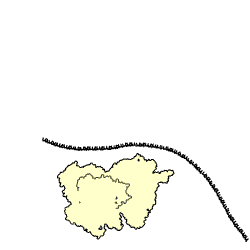Biological computing
The resulting pathway of reactions that takes place constitutes an output, which is based on the engineering design of the biocomputer and can be interpreted as a form of computational analysis.In networks-based biocomputation,[6] self-propelled biological agents, such as molecular motor proteins or bacteria, explore a microscopic network that encodes a mathematical problem of interest.For instance, in the system described by Nicolau et al.,[6] mobile molecular motor filaments are detected at the "exits" of a network encoding the NP-complete problem SUBSET SUM.[4]: 349 For instance, all of the necessary proteins for a certain biochemical pathway, which could be modified to serve as a biocomputer, could be synthesized many times over inside a biological cell from a single DNA molecule.[5] Tom Knight of the MIT Artificial Intelligence Laboratory first suggested a biochemical computing scheme in which protein concentrations are used as binary signals that ultimately serve to perform logical operations.Because of the availability and potential economic efficiency associated with producing biomolecules and biocomputers—as noted above—the advancement of the technology of biocomputers is a popular, rapidly growing subject of research that is likely to see much progress in the future.In March 2013. a team of bioengineers from Stanford University, led by Drew Endy, announced that they had created the biological equivalent of a transistor, which they dubbed a "transcriptor".[8] Parallel biological computing with networks, where bio-agent movement corresponds to arithmetical addition was demonstrated in 2016 on a SUBSET SUM instance with 8 candidate solutions.[9] In 2021, a team led by biophysicist Sangram Bagh realized a study with E. coli to solve 2 x 2 maze problems to probe the principle for distributed computing among cells.[10][11] In 2024, FinalSpark, a Swiss biocomputing startup, launched an online platform enabling global researchers to conduct experiments remotely on biological neurons in vitro.The potential to solve complex mathematical problems using far less energy than standard electronic supercomputers, as well as to perform more reliable calculations simultaneously rather than sequentially, motivates the further development of "scalable" biological computers, and several funding agencies are supporting these efforts.
Bio-inspired computingBrain–brain interfaceBiological computationproteinsreal computationsnanobiotechnologynanometersbiomolecularcomputerchemical reactionsnegative feedbackmechanicalelectrical conductivityelectricityadenosine triphosphateribosomebiological machineprotein dynamicsnanoscalestranslateamino acidsnucleotidesnucleotideribosomesComputational GenesChemically induced dimerizationlogic gatesorganismseconomicalTom KnightbinarybioengineersStanford UniversityDrew Endytransistortranscriptordata storagesystem of logicE. ColiBiotechnologyComputational geneDNA computingHuman biocomputerMolecular electronicsNanotechnologyPeptide computingWetware computerUnconventional computingBibcode